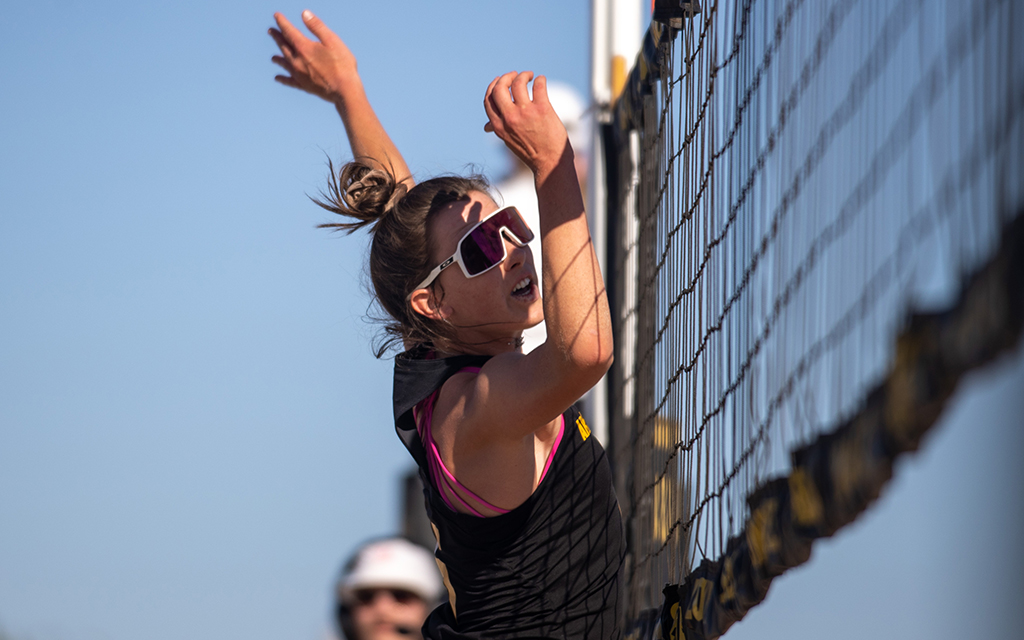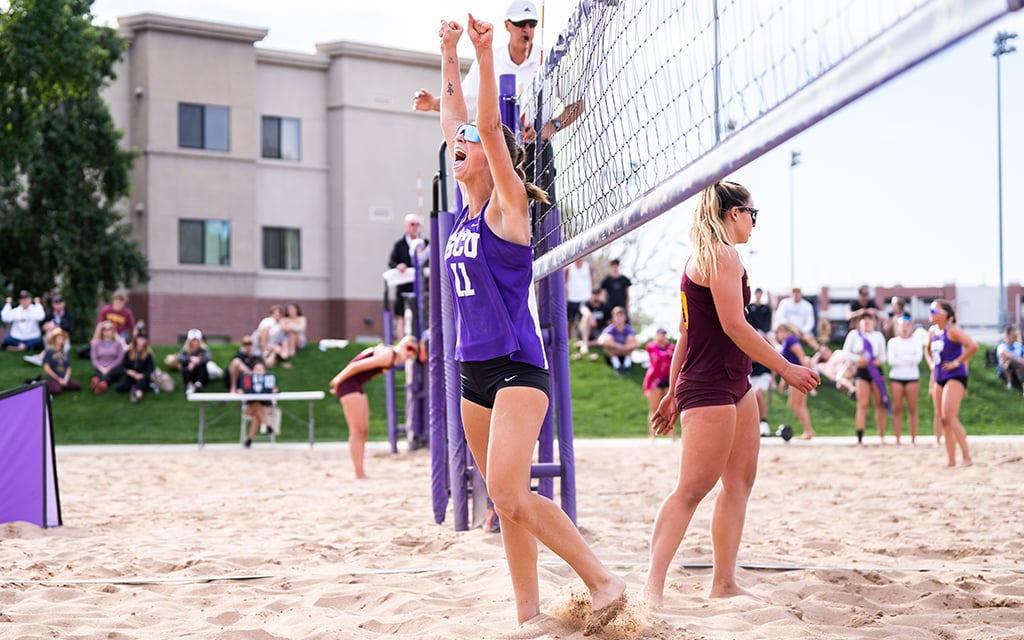PHOENIX – With major championship events on the horizon, Allison Hansen and her Grand Canyon University teammates took to the sand for practice on an ordinary mid-April day.
Hansen came to GCU from Washington, where no sanctioned high school beach volleyball exists and where only a limited amount of months are ideal for the sport outdoors.
“Being able to play year-round I think is super important because back in Seattle, I can’t … because it’s raining, snowing, below freezing,” Hansen said, admiring GCU’s pristine on-campus beach courts, bathed in sunshine on a warm day. “Then here, it’s like 50 degrees and we’re like ‘Yeah, let’s go play.’”
Arizona’s climate is a big factor in the collegiate success of beach volleyball in the state. GCU, Arizona and Arizona State have taken advantage of it to build programs either on the cusp of national success or already achieving it alongside major coastal programs in California and Florida.
And who needs a beach? Of the 16 programs participating in the NCAA Beach Volleyball Championship in Gulf Shores, Alabama, starting Friday, GCU, who faces Stanford, is the farthest from a coast, with many others hugging a coastline.
Breakthrough national success in Phoenix
The most successful of those programs comes at the smallest of the three schools, Grand Canyon.
The Lopes started their beach volleyball program in 2013. It took a second season for the Lopes to find their first win as the inaugural team went 0-10.
After several more average seasons, GCU hired Kristen Rohr to lead the program in August 2015. She had never taken a college coaching job before, making GCU a new challenge in her career.
“I had ran clubs and college prep programs for beach (volleyball), but it was my first college job,” Rohr said. “It was a lot of just learning as I went and calling a lot of my friends and asking them questions.”
She inherited several talented players for her first season in 2016, including eventual All-American Molly Turner. However, a huge task awaited her as a new college coach.
“We had a lot of athletes that had been playing indoor and decided to come over to the beach, but I had 11 people on the team and nine of them were seniors,” Rohr said.
The existing pieces gave GCU enough to earn its first American Volleyball Coaches Association ranking before the 2017 season, when the poll expanded to 15 teams. But sustaining it would come down to proper recruiting.
Her first two classes set a foundation for the program, which saw steady success from 2017 to 2021. It helped the Lopes stay in the AVCA rankings in every poll since their debut in 2017.
However, GCU was still missing a trip to the NCAA tournament heading into 2022. At this point, Rohr’s recruiting early in her tenure at GCU gave the Lopes plenty of talented experience.
“I felt like our 2017 and 2018 recruiting classes were really strong,” Rohr said. “When we got to that 2022 season, we had a mixture of some experience and a mixture of some really, really good talented young players that are still here now.”
The recruiting standard was raised over time as players like Hansen came into the program, ready to make their mark. They were also incredibly motivated to prove GCU belonged in 2022.
“I think we all came together (last year) and we all just decided that we were not going to take no for an answer,” Hansen said. “We were not going to let anything or anyone hold us back from being able to go to the tournament because we have never gone.”
The Lopes’ mindset paid off with a historic 2022 season.
GCU picked up 12 wins against the AVCA top 20, including four wins against teams ranked No. 8. Its only six regular season losses came against top-six teams, with GCU avoiding sweeps in each match.
GCU’s impressive resume, combined with the NCAA expanding its beach volleyball championship to 16 teams for 2022, meant program history seemed inevitable. On April 30, 2022, it became reality with the program’s first selection into the NCAA tournament as a seven seed.
“I think I probably cried,” Rohr said about seeing GCU’s name on the bracket. “It was just a dream of ours to get there … but to actually get to accomplish that goal and be one of those teams, not just me going there and watching it at the end of the season, it was pretty indescribable but just really a taste of what I want our future to continue to be.”
The Lopes fell in the first round to Georgia State in a tight 3-2 loss. But qualifying for the tournament in Gulf Shores marked a significant milestone thanks to years of hard work creating an elite team and elite culture.
Both areas have come by bringing in the right people in recruiting, Rohr said.
“Our goal is to bring in really good people and hope that is going to lead to that family-type culture,” she said.
GCU has set itself up for another shot at the national tournament in 2023. The Lopes have consistently ranked in the top eight of the AVCA poll throughout 2023 and carry a strong resume again, featuring seven wins against ranked teams including two wins against California.

Arizona State’s Lexi Sweeney goes for the block and helps secure a 2-1 win over Arizona’s top duo. The Sun Devils are optimistic their new facilities will help the program find success. (Photo by Damian Rios/Cronkite News)
Pac-12 programs on the cusp
Arizona and Arizona State started their beach volleyball programs one year after GCU did.
The Wildcats and the Sun Devils both began slow with 8-12 and 6-5 records, respectively, in 2014. However, both programs improved in the years after.
Arizona made the biggest gains. The Wildcats went 18-3 in 2015, the year before beach volleyball became a sanctioned sport by the NCAA.
After the sport became sanctioned, the Wildcats found success in a bigger schedule. Arizona has been ranked in the top 15 of the AVCA coaches’ poll in six of the last seven seasons.
Arizona made its NCAA tournament breakthrough in 2016, finishing sixth in the final coaches’ poll. Since then, though, the Wildcats have been on the cusp with no national tournament appearances.
They have had some success against Pac-12 schools in the regular season, including a 9-2 record in 2021. However, that came undone with a 1-2 Pac-12 tournament record.
ASU’s beach volleyball program, meanwhile, has found more rocky waters.
The Sun Devils did not have a winning record in Pac-12 play in program history coming into 2023. Overall, the program has been up and down with just two winning records.
ASU coach Brad Keenan said challenges in the Pac-12 are “always going to be the case.” It is especially true for both the Sun Devils and the Wildcats when having to face powerhouse teams like USC, UCLA, Stanford and California.
ASU got a key lift just before the 2022 season when new facilities next to Farrington Stadium in Tempe opened. The facility includes four courts as well as a scoreboard and grassy areas around the courts for seating. Three of the courts are the main ones used for practice and competition.
This facility gave ASU a stable home, something that was sorely needed. Senior Lexi Sweeney said the program went to several facilities to find court time in her first few years with the Sun Devils.
“We went to Pera Club, went to Tempe Town Lake (and) went to some local parks and I think it’s just nice to have a place that you can come to consistently every single morning and build a foundation for the rest of the team, as well,” she said.
The courts feature sand that Keenan says is deeper than the sport’s most prestigious courts at Manhattan Beach.
“I have not been to a facility that is deeper than this or even comparable,” he said.
While success has still been hard to come by, Keenan said the facility helps the Sun Devils in two key ways. First, matches away from Tempe showcase key technical skills.
“I think the game speeds up for us when we go to other places,” he said. “We are jumping higher, hitting harder. That is always a good thing.”
Second, and perhaps most important, is the team’s stamina and fitness with practices in the deep sand.
“When we get late in the matches, I think we have an advantage there,” Keenan said.
The new facility has helped ASU build better teams with younger players such as sophomore Kylie Wickley. She carried extensive indoor and club beach volleyball experience and won multiple national events in 2021 before arriving in Tempe.
She has played alongside Sweeney as ASU’s No. 1 pair throughout this season. Together, they have an 11-13 match record on the season with four wins against pairs from ranked teams.
Sweeney has been impressed with Wickley throughout the season.
“I think she is an amazing player already,” Sweeney said. “Definitely getting exposure at the ones is the best thing for her. She is already up to the challenge.”
Giving players like Wickley a chance to play early in their college career has been a strong recruiting pitch and program-building strategy for Keenan. He hopes to continue giving younger players a chance until his team’s roster becomes much deeper.
Althogh the mindset has not led to an overall turnaround in recent years, ASU secured a key milestone with an upset win over Arizona April 21. The Sun Devils sealed a sixth conference win and a winning record in Pac-12 regular season play, both a first for the program.

Arizona has come on strong in recent years and has been ranked in the top 15 of the AVCA coaches’ poll in six of the last seven seasons. (Photo courtesy of Arizona Athletics)
National opportunities await
All three programs have a better chance at finding national success thanks to the NCAA expanding the beach volleyball tournament last year. The 2022 event had its first round played out in single-elimination style with the rest of the tournament determined by a double elimination bracket.
This year, the national tournament changes to a strict single elimination tournament for the first time. In addition, a ninth automatic bid was added to the field this year thanks to the Sun Belt Conference sponsoring the sport for the first time, meaning the tournament will feature an opening round dual and 17 teams.
The expansion gives programs like ASU and Arizona a more manageable target to get into the NCAA tournament, especially in the Pac-12.
“If you are in the top three in the Pac-12, you are in the top 16 nationally. That’s just pretty much a given,” Keenan said.
He thinks that mark is not too far away for the Sun Devils.
“I would say in the next two to three years, we should be fighting for that top three spot in the conference,” Keenan said.
Sweeney sees that same potential not just from her partner Wickley, but from the rest of the freshmen and sophomores. She said that, combined with a good incoming class, has ASU positioned well for a breakout season.
“Just with the way that things are shifting now, I do think that ASU is going to see its day in the sun,” Sweeney said.
GCU’s challenge, meanwhile, is trying to maintain its newfound success. Heading into the 2023 season, it gave itself another avenue to making the NCAA tournament by joining a beach volleyball conference for the first time.
That new home, the Coastal Collegiate Sports Association, features some of the top beach volleyball programs in the country. Three top six teams in the current AVCA poll – TCU, LSU and Florida State – are in the CCSA as well as No. 16 South Carolina and Missouri State.
Rohr said she is looking forward to her team being able to take part in conference tournaments like most other national powers before NCAA tournaments in the future.
“Having that talent in one event, I feel like it is such an advantage because you are getting top competition before you even go (to the national tournament),” she said.
Rohr also said high-profile recruiting targets are more manageable because of the program’s success.
“We are not getting the athletes that are looking at the top 10 schools in the country,” she said. “Better and better finishes just gets us higher up on that list. So, we go after the best in the country and hope we can snag one or two here and there.”
Recruiting will be a priority, especially with several key players leaving the program after 2023. GCU does feature a large freshman class with some players like Sydnee Broadway picking up playing time this season against less-caliber opponents.
High recruiting aspirations plus a demanding conference to test skills all assist Rohr in her hopes for GCU to not just contend with national powerhouses, but become one.
“We want to be competing for a national championship and not just be there on day one, but be there at the end of the tournament,” Rohr said.
Despite different short-term objectives, all three major programs are able to make each other better throughout the year thanks to plenty of matchups in the spring and fall and an expanded fall schedule allowed by the NCAA that fits the sport and especially Arizona’s year-round ideal weather.
“It helps that we are able to scrimmage each other in the fall and offseason as well because you are just playing against great players year-round now,” Sweeney said.

